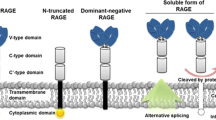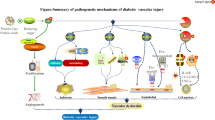Abstract
Diabetes mellitus has now reached epidemic proportions in the Western world. The associated microvascular and macrovascular complications are a result of severe metabolic derangement, which leads to chronic tissue injury. Although there are a number of proposed pathophysiologic mechanisms for the vascular complications associated with diabetes, this review focuses predominantly on the role of advanced glycation end products (AGEs) in the pathogenesis of diabetes-associated atherosclerosis. The potential role of AGEs in enhancing arterial stiffness, an entity occurring with a greater prevalence in populations known to have higher-than-normal AGE levels, is also examined. Pharmacologic interventions aimed at reducing the level of these chemical compounds or interrupting their action provide hope for the future treatment of both atherosclerotic vascular disease and systolic hypertension, particularly in the setting of diabetes.
Similar content being viewed by others
References and Recommended Reading
King GL, Wakasaki H: Theoretical mechanisms by which hyperglycemia and insulin resistance could cause cardiovascular diseases in diabetes. Diabetes Care 1999, 22 Suppl 3:C31-C37.
The effect of intensive treatment of diabetes on the development and progression of long-term complications in insulin-dependent diabetes mellitus. The Diabetes Control and Complications Trial Research Group. N Engl J Med 1993, 329:977–986.
Lewis EJ, Hunsicker LG, Clarke WR, et al.: Renoprotective effect of the angiotensin-receptor antagonist irbesartan in patients with nephropathy due to type 2 diabetes. N Engl J Med 2001, 345:851–860.
Parving HH, Lehnert H, Brochner-Mortensen J, et al.: The effect of irbesartan on the development of diabetic nephropathy in patients with type 2 diabetes. N Engl J Med 2001, 345:870–878.
Chaturvedi N, Sjolie AK, Stephenson JM, et al.: Effect of lisinopril on progression of retinopathy in normotensive people with type 1 diabetes. The EUCLID Study Group. EURODIAB Controlled Trial of Lisinopril in Insulin-Dependent Diabetes Mellitus. Lancet 1998, 351:28–31.
Brenner BM, Cooper ME, de Zeeuw D, et al.: Effects of losartan on renal and cardiovascular outcomes in patients with type 2 diabetes and nephropathy. N Engl J Med 2001, 345:861–869.
de Vegt F, Dekker JM, Ruhe HG, et al.: Hyperglycaemia is associated with all-cause and cardiovascular mortality in the Hoorn population: the Hoorn Study. Diabetologia 1999, 42:926–931.
Cines DB, Pollak ES, Buck CA, et al.: Endothelial cells in physiology and in the pathophysiology of vascular disorders. Blood 1998, 91:3527–3561.
Gu L, Okada Y, Clinton SK, et al.: Absence of monocyte chemoattractant protein-1 reduces atherosclerosis in low density lipoprotein receptor-deficient mice. Mol Cell 1998, 2:275–281.
Libby P, Aikawa M: New insights into plaque stabilisation by lipid lowering. Drugs 1998, 56(Suppl 1):9–13; discussion 33.
Libby P: Current concepts of the pathogenesis of the acute coronary syndromes. Circulation 2001, 104:365–372.
Celentano DC, Frishman WH: Matrix metalloproteinases and coronary artery disease: a novel therapeutic target. J Clin Pharmacol 1997, 37:991–1000.
Brownlee M, Cerami A, Vlassara H: Advanced glycosylation end products in tissue and the biochemical basis of diabetic complications. N Engl J Med 1988, 318:1315–1321.
Brownlee M: Biochemistry and molecular cell biology of diabetic complications. Nature 2001, 414:813–820.
Fu S, Fu MX, Baynes JW, et al.: Presence of dopa and amino acid hydroperoxides in proteins modified with advanced glycation end products (AGEs): amino acid oxidation products as a possible source of oxidative stress induced by AGE proteins. Biochem J 1998, 330(Pt_1):233–239.
Bucala R: Lipid and lipoprotein modification by advanced glycosylation end-products: role in atherosclerosis. Exp Physiol 1997, 82:327–337.
Brownlee M: Advanced protein glycosylation in diabetes and aging. Annu Rev Med 1995, 46:223–234.
Makita Z, Radoff S, Rayfield EJ, et al.: Advanced glycosylation end products in patients with diabetic nephropathy. N Engl J Med 1991, 325:836–842.
Tanaka S, Avigad G, Brodsky B, et al.: Glycation induces expansion of the molecular packing of collagen. J Mol Biol 1988, 203:495–505.
Charonis AS, Reger LA, Dege JE, et al.: Laminin alterations after in vitro nonenzymatic glycosylation. Diabetes 1990, 39:807–814.
Laurent S, Boutouyrie P, Asmar R, et al.: Aortic stiffness is an independent predictor of all-cause and cardiovascular mortality in hypertensive patients. Hypertension 2001, 37:1236–1241.
Cruickshank K, Riste L, Anderson SG, et al.: Aortic pulsewave velocity and its relationship to mortality in diabetes and glucose intolerance: an integrated index of vascular function? Circulation 2002, 106:2085–2090.
Berry KL, Skyrme-Jones RA, Cameron JD, et al.: Systemic arterial compliance is reduced in young patients with IDDM. Am J Physiol 1999, 276(6 Pt 2):H1839-H1845.
Henry RM, Kostense PJ, Spijkerman AM, et al.: Arterial stiffness increases with deteriorating glucose tolerance status: the Hoorn Study. Circulation 2003, 107:2089–2095.
Schram MT, Henry RM, van Dijk RA, et al.: Increased central artery stiffness in impaired glucose metabolism and type 2 diabetes: the Hoorn Study. Hypertension 2004, 43:176–181. This population-based study of 619 patients demonstrates how central and peripheral arterial stiffness is independently associated with impaired glucose tolerance and frank diabetes.
McVeigh GE, Morgan DJ, Finkelstein SM, et al.: Vascular abnormalities associated with long-term cigarette smoking identified by arterial waveform analysis. Am J Med 1997, 102:227–231.
Cohn JN, Finkelstein SM: Abnormalities of vascular compliance in hypertension, aging and heart failure. J Hypertens Suppl 1992, 10:S61-S64.
Leibovitz E, Hazanov N, Zimlichman R, et al.: Treatment with atorvastatin improves small artery compliance in patients with severe hypercholesterolemia. Am J Hypertens 2001, 14(11 Pt 1):1096–1098.
Kimoto E, Shoji T, Shinohara K, et al.: Preferential stiffening of central over peripheral arteries in type 2 diabetes. Diabetes 2003, 52:448–452.
Brownlee M, Vlassara H, Kooney A, et al.: Aminoguanidine prevents diabetes-induced arterial wall protein cross-linking. Science 1986, 232:1629–1632.
Wolffenbuttel BH, Boulanger CM, Crijns FR, et al.: Breakers of advanced glycation end products restore large artery properties in experimental diabetes. Proc Natl Acad Sci U S A 1998, 95:4630–4634.
Vaitkevicius PV, Lane M, Spurgeon H, et al.: A cross-link breaker has sustained effects on arterial and ventricular properties in older rhesus monkeys. Proc Natl Acad Sci U S A 2001, 98:1171–1175.
Kass DA, Shapiro EP, Kawaguchi M, et al.: Improved arterial compliance by a novel advanced glycation end-product crosslink breaker. Circulation 2001, 104:1464–1470.
Beckman JA, Creager MA, Libby P: Diabetes and atherosclerosis: epidemiology, pathophysiology, and management. JAMA 2002, 287:2570–2581.
Schmidt AM, Yan SD, Yan SF, et al.: The multiligand receptor RAGE as a progression factor amplifying immune and inflammatory responses. J Clin Invest 2001, 108:949–955.
Yeh CH, Sturgis L, Haidacher J, et al.: Requirement for p38 and p44/p42 mitogen-activated protein kinases in RAGEmediated nuclear factor-kappaB transcriptional activation and cytokine secretion. Diabetes 2001, 50:1495–1504.
de Winther MP, Kanters E, Kraal G, et al.: Nuclear factor kappaB signaling in atherogenesis. Arterioscler Thromb Vasc Biol 2005, 25:904–914.
Wautier MP, Chappey O, Corda S, et al.: Activation of NADPH oxidase by AGE links oxidant stress to altered gene expression via RAGE. Am J Physiol Endocrinol Metab 2001, 280:E685-E694.
Leopold JA, Loscalzo J: Oxidative enzymopathies and vascular disease. Arterioscler Thromb Vasc Biol 2005, 25:1332–1340.
Park L, Raman KG, Lee KJ, et al.: Suppression of accelerated diabetic atherosclerosis by the soluble receptor for advanced glycation endproducts. Nat Med 1998, 4:1025–1031.
Bucciarelli LG, Wendt T, Qu W, et al.: RAGE blockade stabilizes established atherosclerosis in diabetic apolipoprotein E-null mice. Circulation 2002, 106:2827–2835.
Forbes JM, Yee LT, Thallas V, et al.: Advanced glycation end product interventions reduce diabetes-accelerated atherosclerosis. Diabetes 2004, 53:1813–1823.
Sakata N, Imanaga Y, Meng J, et al.: Immunohistochemical localization of different epitopes of advanced glycation end products in human atherosclerotic lesions. Atherosclerosis 1998, 141:61–75.
Niwa T, Katsuzaki T, Miyazaki S, et al.: Immunohistochemical detection of imidazolone, a novel advanced glycation end product, in kidneys and aortas of diabetic patients. J Clin Invest 1997, 99:1272–1280.
Ritthaler U, Deng Y, Zhang Y, et al.: Expression of receptors for advanced glycation end products in peripheral occlusive vascular disease. Am J Pathol 1995, 146:688–694.
Cipollone F, Iezzi A, Fazia M, et al.: The receptor RAGE as a progression factor amplifying arachidonate-dependent inflammatory and proteolytic response in human atherosclerotic plaques: role of glycemic control. Circulation 2003, 108:1070–1077.
Burke AP, Kolodgie FD, Zieske A, et al.: Morphologic findings of coronary atherosclerotic plaques in diabetics: a postmortem study. Arterioscler Thromb Vasc Biol 2004, 24:1266–1271.
Kanauchi M, Tsujimoto N, Hashimoto T: Advanced glycation end products in nondiabetic patients with coronary artery disease. Diabetes Care 2001, 24:1620–1623.
Falcone C, Emanuele E, D’Angelo A, et al.: Plasma levels of soluble receptor for advanced glycation end products and coronary artery disease in nondiabetic men. Arterioscler Thromb Vasc Biol 2005, 25:1032–1037.
Intensive blood-glucose control with sulphonylureas or insulin compared with conventional treatment and risk of complications in patients with type 2 diabetes (UKPDS 33). UK Prospective Diabetes Study (UKPDS) Group. Lancet 1998, 352:837–853.
Esposito K, Giugliano D, Nappo F, et al.: Regression of carotid atherosclerosis by control of postprandial hyperglycemia in type 2 diabetes mellitus. Circulation 2004, 110:214–219.
Marfella R, Esposito K, Giunta R, et al.: Circulating adhesion molecules in humans: role of hyperglycemia and hyperinsulinemia. Circulation 2000, 101:2247–2251.
Author information
Authors and Affiliations
Corresponding author
Rights and permissions
About this article
Cite this article
Soldatos, G., Cooper, M.E. Advanced glycation end products and vascular structure and function. Current Science Inc 8, 472–478 (2006). https://doi.org/10.1007/s11906-006-0025-8
Issue Date:
DOI: https://doi.org/10.1007/s11906-006-0025-8




